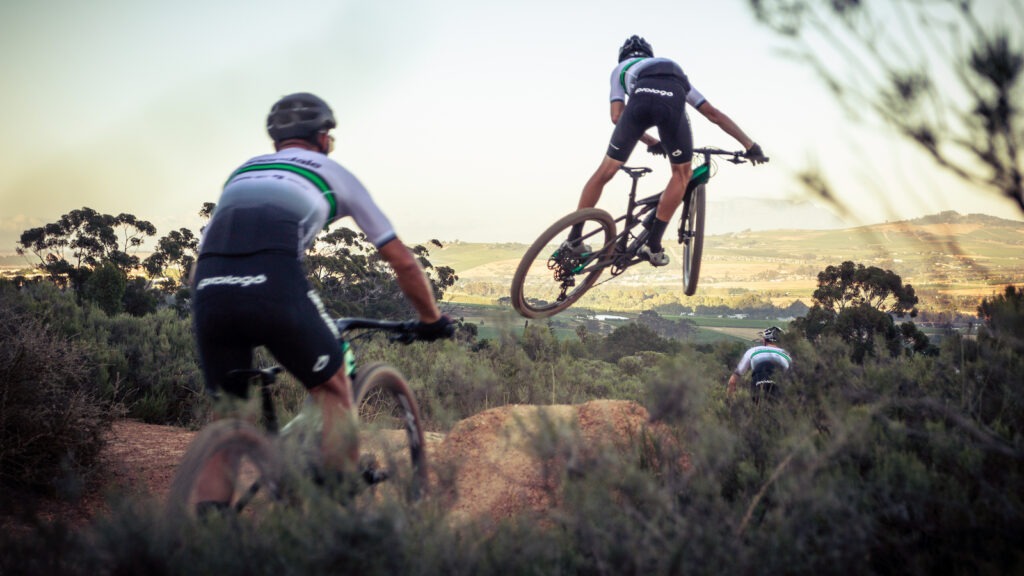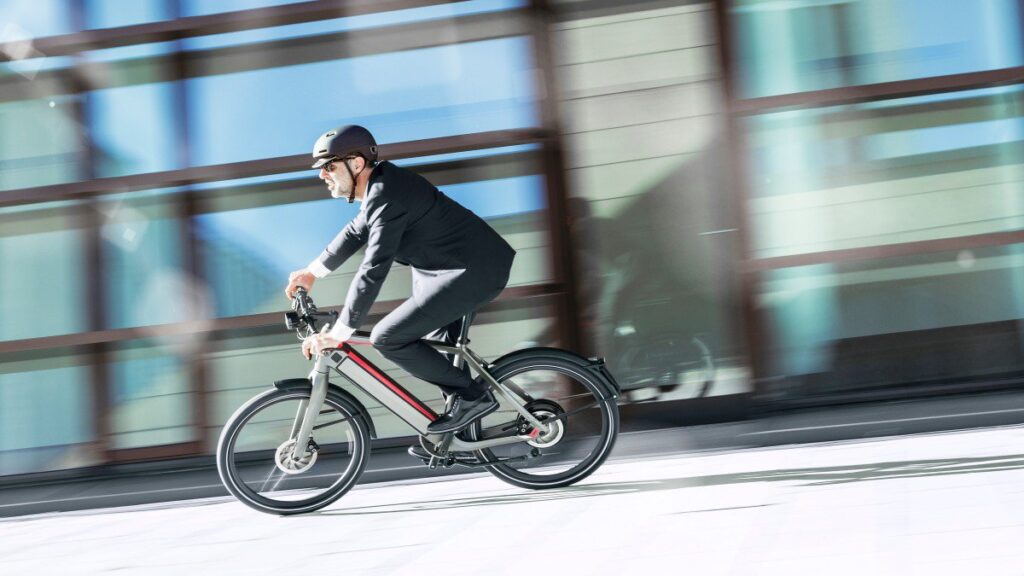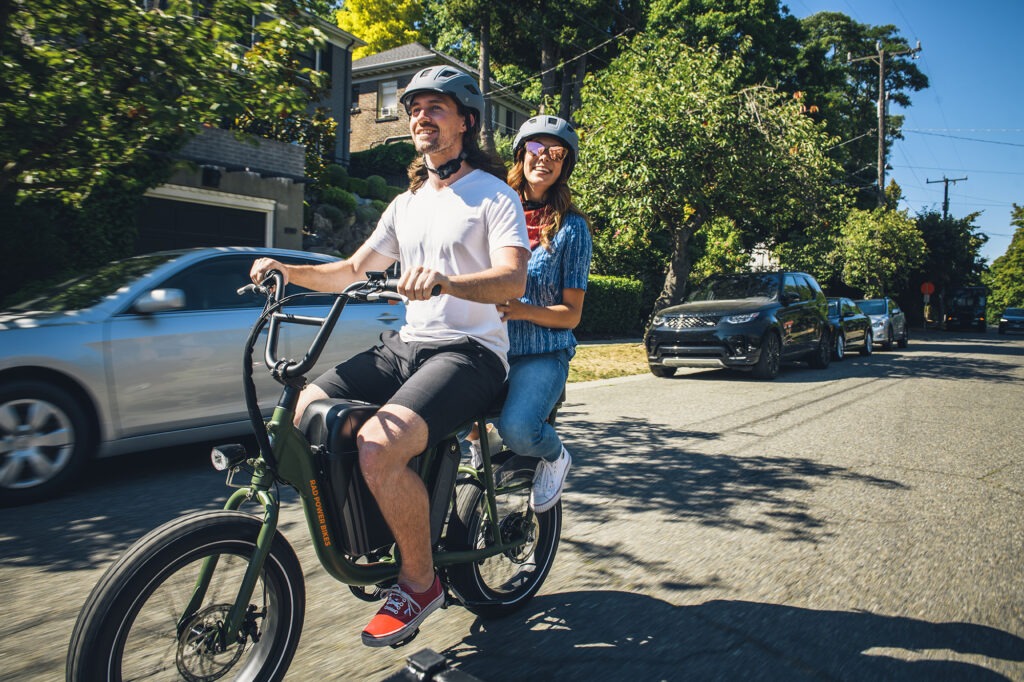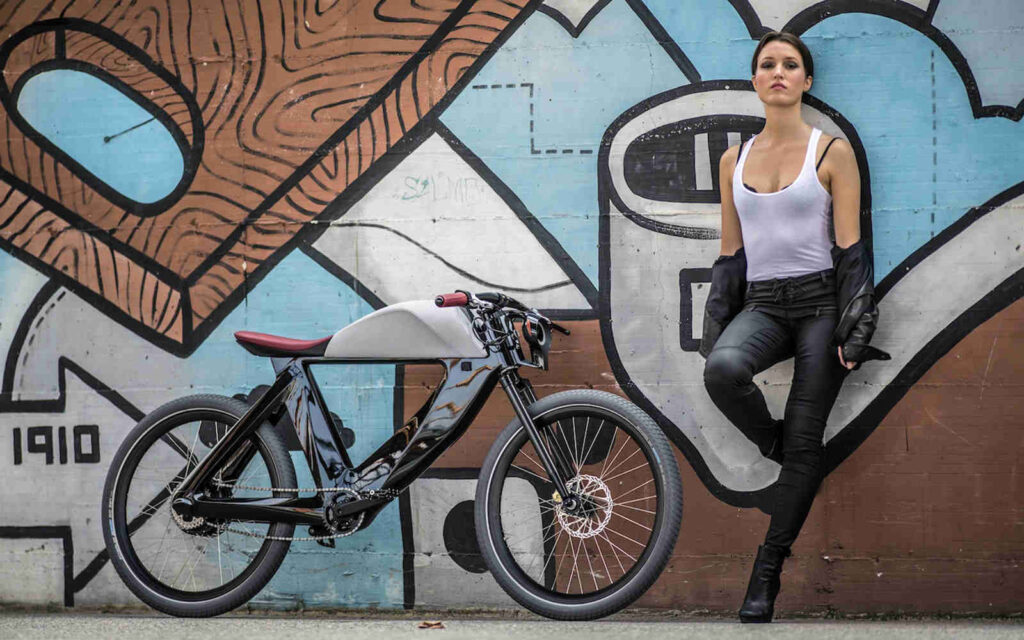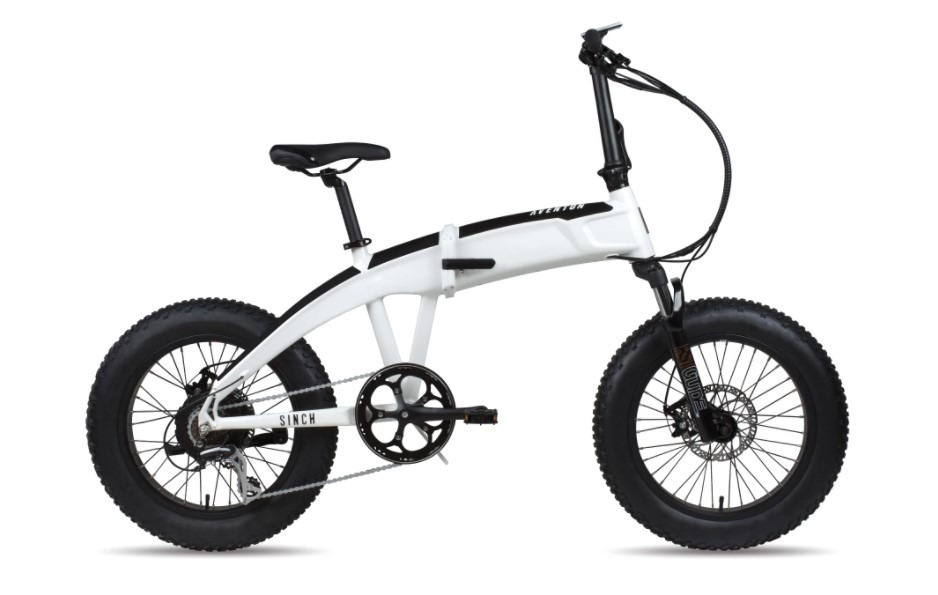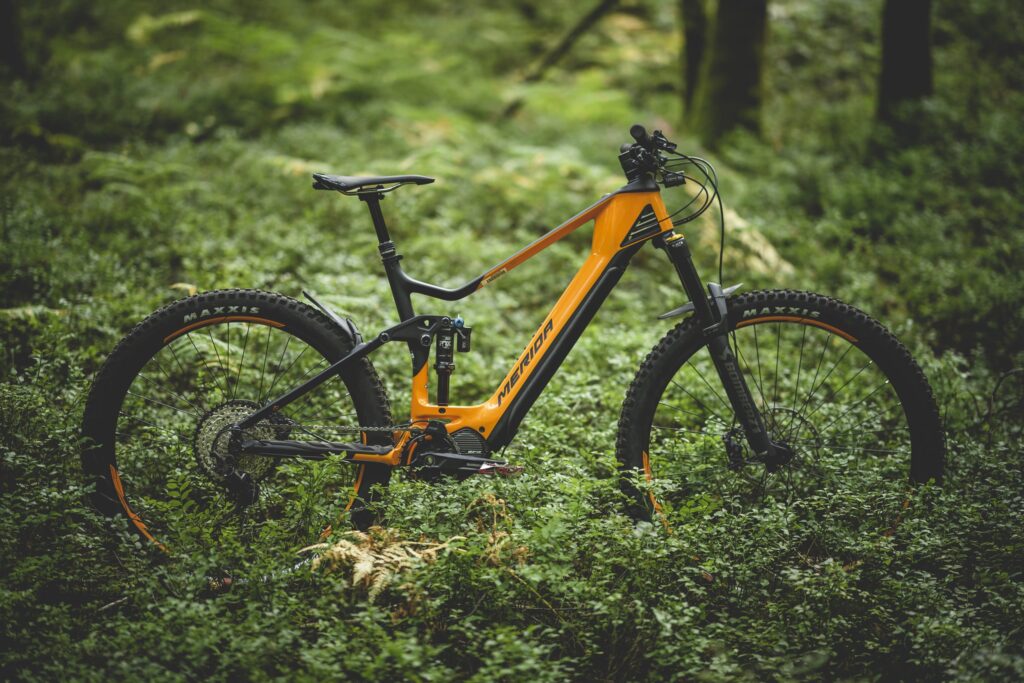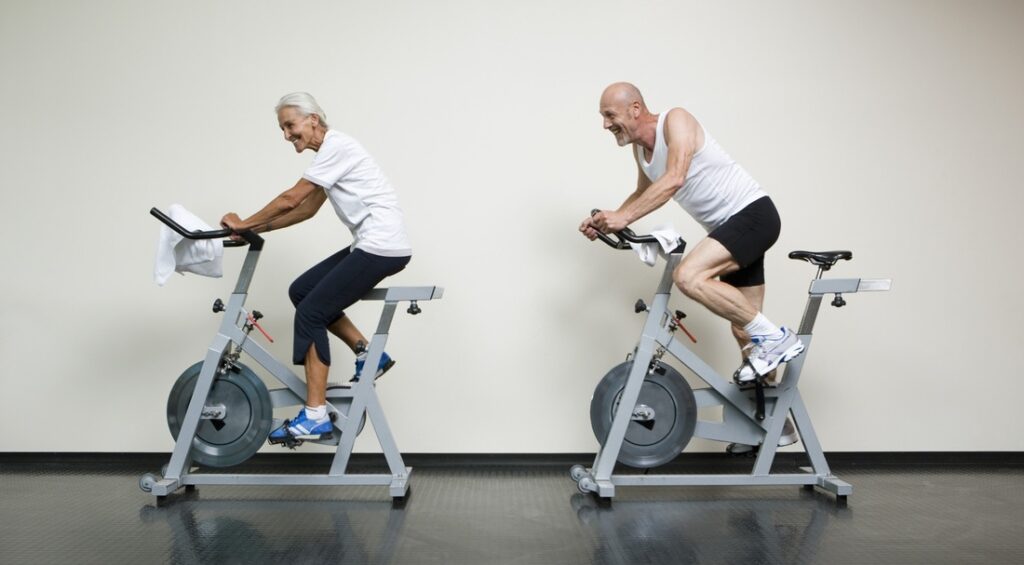Looking for the best beginner mountain bike can be a little tough. There are different types of mountain bikes, suspension systems, and biking styles that you have to be familiar with. In this post, we are going to start with the basics of mountain biking, and then go all the way to discuss some of the best beginner MTB models that you can buy in 2025.
>> Don’t Miss:
- 10 Best Beach Cruiser Bikes in 2025 (Reviews & Buying Guide)
- 10 Best Balance Bikes for Your Kids (2025)
- 15 Best BMX Bikes for Kids and Adults in 2025
- 8 Best Bikes for Women in 2025
- 10 Best Budget Mountain Bikes in 2025
- 10 Best Mountain Bikes Under $500 in 2025
Table of Contents
Best Beginner Mountain Bike: Comparison Chart
Types of Mountain Bikes
If you want to learn about mountain bikes well enough to be able to pick the best beginner mountain bike, you need to first get familiar with the different types.
When it comes to discussing the types of mountain bikes, some people can confuse the ‘Hardtail’ and ‘Fully’ suspension systems with the other frame-based classifications like ‘Cross-country’ and ‘Downhill’.
So, before we go on to talk about the different types of mountain bikes concerning biking styles, let’s first clear up what ‘Hardtail’ and ‘Fully’ suspensions mean.
‘Hardtail’ bikes only have suspension in the front wheel whereas ‘Fully’ refers to the setup where both the front and back wheel have suspension.
The latter can be useful for bumpy rides across rough terrain. Since both wheels have suspension, the overall shock-absorbing capability of the bike is improved…which means fewer jitters for the rider.
On the other hand, hardtail bikes can be better if you want to ride on smooth and flat terrain. Although the lack of suspension on the back wheel does compromise the shock-absorbing capability of the bike, it compensates by providing better agility on flat surfaces.
Now that we are all caught up on the suspension setups, let’s move on to discussing the types of mountain bikes.
Cross-country Bikes
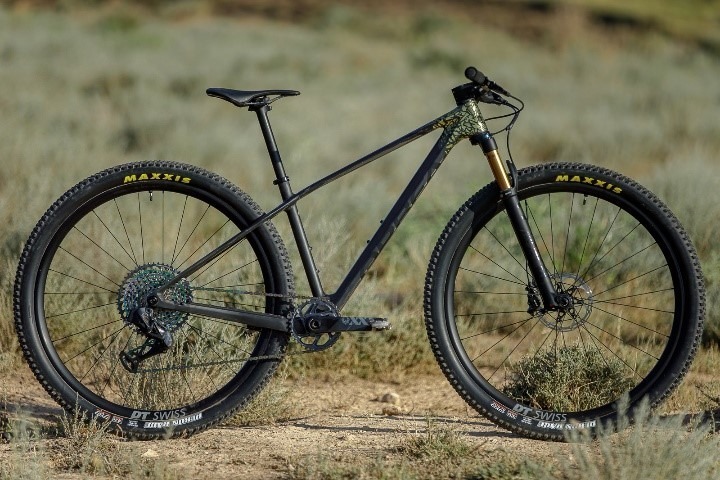
Cross-country bikes, as the name somewhat indicates, are mainly for riding on flat and smooth terrain such as forest tracks and open fields.
They have a hardtail suspension setup, and they are not suitable to use for steep or rough biking.
As we mentioned earlier, the selling point of the hardtail suspension system is agility. The slim and baring frames on cross-country bikes combined with the agility of hardtail suspensions add up to an overall quick and fast riding experience.
Downhill Mountain Bikes

Downhill mountain bikes can be identified by their distinct low-seat frame structure. These bikes are made to withstand bumps and shocks while also helping the rider retain balance. That is why they have thick tires and a low-saddle frame.
And that is, while we are on it, the same reason for the generously wide handlebars. They provide better control and balance to the rider during the speedy and slopey downhill rides.
As you can guess, downhill MTBs come with the ‘fully’ suspension setup.
Freeride Mountain Bikes
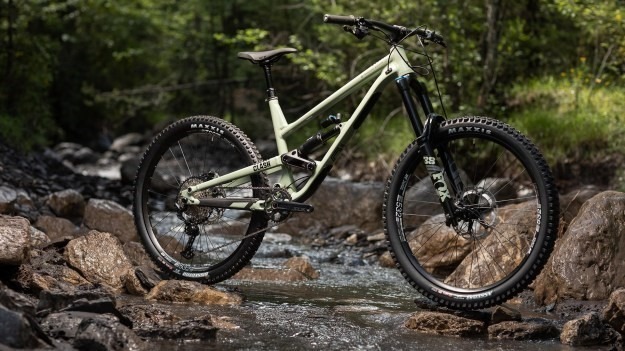
So, cross-country bikes are for flat surfaces while downhill bikes are for rough terrains. That much we saw up till now.
However, there is also a middle line – a hybrid – between these two types i.e., something that is not as heavy as a downhill bike nor is completely light like an XC.
And that is the freeride MTB.
Freeride MTBs come with full suspension systems, and they are comparatively lighter than downhill bikes although not as much as cross-country ones.
There are some other types of MTBs as well, but mentioning them all would take us a little away from the main topic of this post. Understanding the types of bikes mentioned above should be enough for you to get started with looking for the best beginner mountain bike to buy in 2025.
Mountain Biking Styles
Once we have understood the different types of MTN bike frames and suspension setups, understanding the various mountain biking styles isn’t that hard.
We do want to get started with discussing some of the best beginner mountain bike models, so let’s keep this part short.
- Cross-country
Cross-country biking is usually done on flat and smooth terrain. Cross-country mountain bikes are used for this type of riding.
- Downhill
Downhill biking is done on steep trails and pathways. Downhill tracks usually have lots of bumps and jumps.
- All Mountain
All mountain biking is more or less what the name says. It’s mainly done in the mountains.
The bikes that are used for this style have good ascending and descending capabilities. They are not particularly only for downhill or uphill rides.
- Fatbiking
Fatbiking is usually done on rough and uneven surfaces such as sand, wet gravel, ice etcetera. Fatbiking requires ‘Fat’ MTBs; which are usually recognizable by their fat tires.
These bikes don’t have any suspension system.
- Freeride
Freeride is a mix of cross-country and downhill biking. It involves a lesser steep terrain as compared to downhill mountain biking, but with slightly more obstacles and action as compared to simply cross-country biking.
- Enduro
Enduro biking is a mix between the ‘All Mountain’ and ‘Freeride’ biking styles. The bikes that are used for this style are pretty much all-rounders. They are made to withstand jumps and drops. They are also good for steep downhill rides, but at the same time, they are not that difficult to ride uphill as well.
What Are the Best Mountain Bikes for Beginners?
Let’s take a look at some of the best beginner mountain bike models that you can buy in 2025.
1. Schwinn Bonafide Mens Mountain Bike
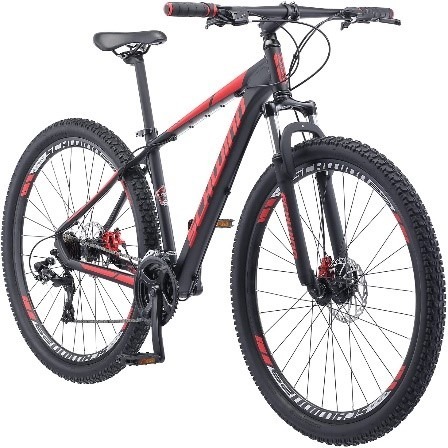
Although looks don’t matter a lot when it comes to talking about the performance of a beginner trail bike, we still have to point out the sleek aluminum frame on the Schwinn Bonafide bike. The black and red color combination along with the frame structure gives this bike an elegant and aesthetic look. For people who want to buy a good starter mountain bike that looks and runs well, the Schwinn Bonafide is the way to go.
The bike has 29-inch wheels, and it comes equipped with a powerful front suspension. There’s none on the back wheel, which makes this a ‘hardtail’ bike.
| Wheel Size | 29 inches |
| Wheel Thickness | 2.25 inches |
| Suspension Setup | Hardtail |
Pros:
- Excellent looks
- Durable aluminum frame
- Thick 2.25-inch wheels
- Comes with 24-speed trigger shifters
Cons:
- Pricey
Highlights:
The main highlights of this MTN bike are 1) the 24-speed trigger shifters, and 2) the aesthetic black/red aluminum frame.
With the 24-speed trigger shifters, you can adjust your riding experience for different trails and terrains.
2. Mongoose Status Mountain Bike
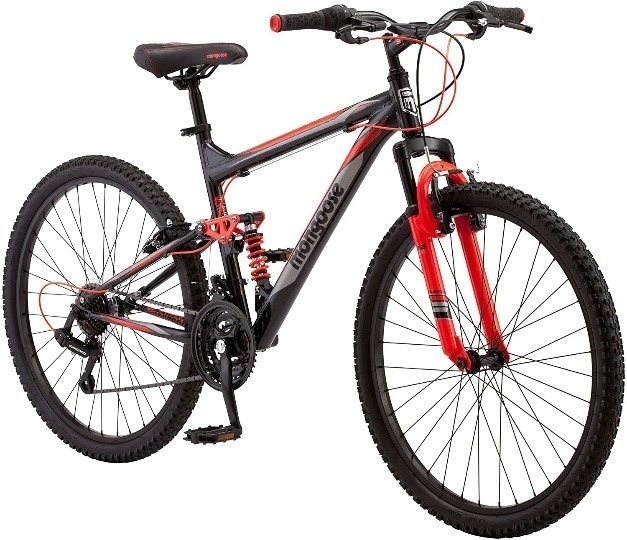
The Mongoose Status Mountain Bike is, incidentally, similar to the Schwinn Bonafide Men’s Mountain Bike as far as looks are concerned. This MTN bike also comes with an aluminum frame and is available in a black/red combination (among others).
Unlike the Schwinn, however, the Mongoose Status has suspension on the rear wheel, which makes it a ‘Fully’ bike.
| Wheel Size | 26 inches |
| Wheel Thickness | 2.125 inches |
| Suspension Setup | Fully |
Pros:
- Available in three different color variations
- Sleek and aesthetic design
- 2.125” thick knobby tires for good tread and traction
- 21-speed twist shifters for speed adjustment
Cons:
- The 26-inch frame size is not suitable for taller riders
Highlights:
The things that we liked particularly about the Mongoose Status were the ‘Fully’ suspension and the aesthetic design. Stylish appearances can be the top priority for a lot of riders, and we think that the Mongoose Status is sure to satisfy the aesthetics connoisseurs.
Being full, the Mongoose can be used on different trails and terrains. Fully bikes have better shock-absorbing ability, and they are good for bumpy rides with lots of drops and jumps.
3. Co-op Cycles DRT 1.1 Bike
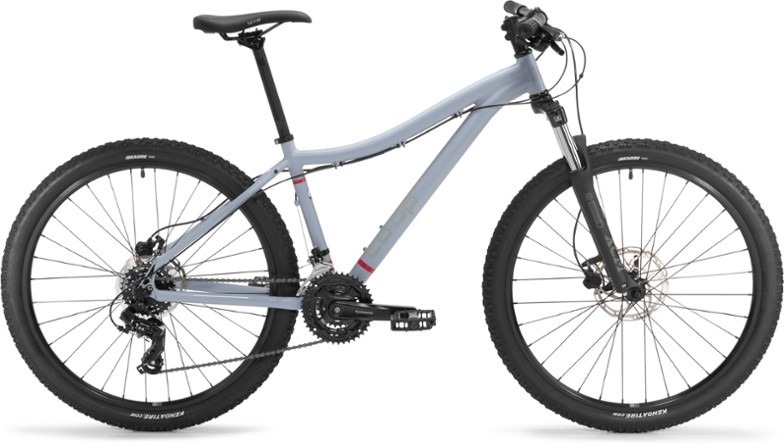
To start, the Co-op Cycles DRT 1.1 has a hefty price tag…at least when compared to the other two bikes discussed so far on this list.
However, the $599 price tag is, in our opinion, justified by the host of awesome features that this bike comes with.
For one, this MTN bike is available in five different sizes; from XS to XL. Although the looks of the DRT 1.1 are not as flashy as the Mongoose Status or the Schwinn Bonafide, it still has an aesthetic and minimalist design.
With the 100mm suspension fork travel time and the hardtail suspension setup, the DRT 1.1 is best for riding on smooth and flat surfaces.
It is one of the best beginner mountain bike models for riders who can afford to spend generously on their first, and are looking to ride on plain and flat terrain with little to no jumps and drops.
| Wheel Size | 27.5 inches |
| Wheel Thickness | 2.1 inches |
| Suspension Setup | Hardtail |
Pros:
- Five sizes available
- Durable aluminum frame
- 21-speed Shimano shifters
- Hydraulic disk brakes
Cons:
- Costly
Highlights:
Unlike the Mongoose Status, the DRT 1.1 comes with Shimano shifters, which are easier to use than the standard twist shifters.
Similarly, the 27.5-inch wheel size is a nice mid-line between the 29-inch and 26-inch wheels, which makes it good for tall and short riders.
4. Batch the Mountain 29” Hardtail Mountain Bike
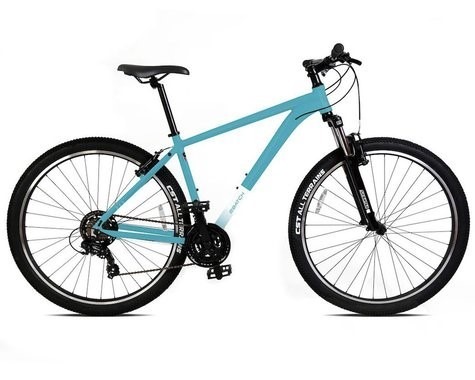
The Batch Bicycles 29” Hardtail Mountain Bike comes with an alloy frame and front suspension with 100 millimeters of travel.
Unlike the usual aluminum bikes, the Batch Bicycles 29″ MTB is made for more light and casual use. It is recommended to use this bike on flat trails that don’t have any steep drops and jumps.
And since beginners, in general, have to start with this type of gentle biking, we could simply say the Batch Bicycles 29” MTB is one of the best beginner mountain bike models for…beginners.
| Wheel Size | 29 inches |
| Wheel Thickness | 2.1 inches |
| Suspension Setup | Hardtail |
Pros:
- 7-speed drivetrain
- 100mm suspension travel
- Two different sizes are available (‘M’ and ‘L’)
Cons:
- The alloy frame is less tough than aluminum
Highlights:
29-inch wheel size and 7-speed Shimano drivetrain is not something that you’ll find easily for $499. The highlight of this MTN bike is, in our opinion, its affordability with the features it offers.
It’s also a good beginner mountain bike for tall riders thanks to the large wheel size.
5. Diamondback Bicycles Cobra 20 Youth 20” Wheel Mountain Bike
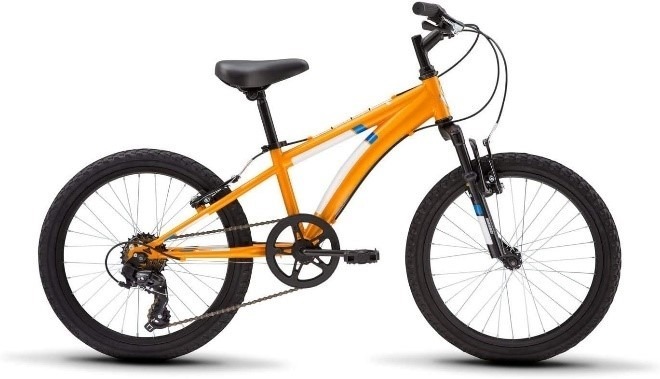
Who said trail mountain biking was just for adults?
The Diamondback Cobra 20” mountain bike comes with a 6-speed Shimano drivetrain and a front suspension with a 40mm travel distance.
The recommended age for this bike is 4 – 9 years. If you want to take your kid along with you on those trail rides, go ahead and buy the Diamondback Cobra 20” MTB.
| Wheel Size | 20 inches |
| Wheel Thickness | – |
| Suspension Setup | Hardtail |
Pros:
- Steel construction
- Affordable
- 6-speed Shimano drivetrain
- 40mm travel gives good shock absorption
Cons:
- Heavy (for children)
Highlights:
The selling point of this bike is the affordable price tag. Although smaller sizes do come with smaller prices, the Diamondback Youth 20 is still very reasonable at just ~$240.
6. Marin Palisades Trail 2 27.5” Bike 2021
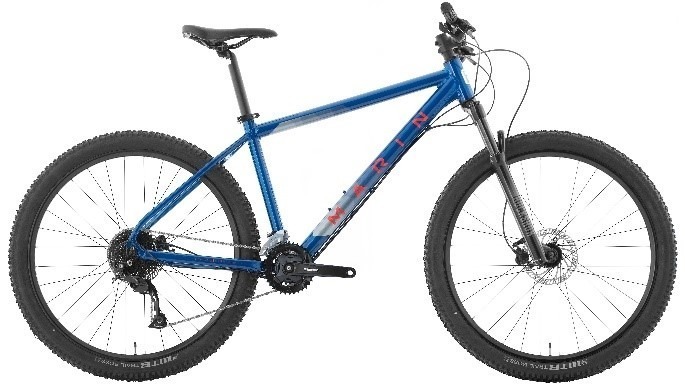
| Wheel Size | 27.5 inches |
| Wheel Thickness | 2.25 inches |
| Suspension Setup | Hardtail |
Wrapping up our list, we have the Marin Palisades Trail 2.
Before we go on to discuss the features, we think it’s wise to tell you about the price tag first. It’s not going to be good if you get your mouth watering, and then come to find out that the price is way beyond your budget.
The Marin Palisades Trail 2 is for, to be a little exquisite, the bourgeois. It comes with a price tag of $713; which is not something a lot of people can spend…, especially on their first mountain bike.
But, to be fair, the high price is justified. Everything about the Marin Palisades Trail 2 – even the name – has a premium feel to it. Features like the elegant frame, the 2 x 9-speed Shimano drivetrain, and the hydraulic disk brakes are all worth the $700+ price tag.
Pros:
- Aesthetic frame and color
- 9-speed Shimano drivetrain
- Comes with a bottle cage mount
- Hydraulic disk brakes for better control
- Three different sizes are available
Cons:
- Pricey
Highlights:
The main highlights of the Marin Palisades Trail 2 are the advanced drivetrain mechanism and its appearance. 9-speed drivetrains are not that common. MTBs usually have 7-speed or 6-speed (as was the case with the Diamondback) drivetrains.
Secondly, the aesthetics of the Marin Palisades are outstanding. It’s just the right amount of snazzy: not too much, not too little.
How to Choose a Beginner Mountain Bike?
Here is how you can choose the best beginner mountain bike for yourself:
Select Your Size
There are different sizes of mountain bikes. The sizes can vary from 26, 27.5, and 29 inches for adults. To get an exact idea of which size would be suitable for your height, you can refer to an online guide such as this one.
Determine the Needed Suspension System
The next thing you need to do is choose a suspension system. We discussed these in detail at the start of this post. But let’s do a quick recap.
If you are looking to ride on flat and smooth terrains, you should look for a bike that has a hardtail suspension setup.
On the other hand, if you are looking to ride on bumpy and uneven tracks, you should get a full bike since they have the better shock-absorbing ability.
Set a Budget
And lastly, to choose a mountain bike, you should decide your budget range. The price tags can vary from brand to brand.
How to Dress for Mountain Biking
If we wanted to discuss how you should dress for mountain biking in detail, it would take up quite a lot of space. So, let’s discuss it briefly in some bullet points.
- Be sure to wear proper outdoor shoes. Don’t go biking in your flip-flops. Having a good and firm grip on your pedals is important.
- Wear long socks. Socks can be a good way to prevent scratches and minor injuries to your ankle and lower calf area.
- Try and wear waterproof trousers/pants. This applies if you are going to ride on forest trails and other wet places.
- Don’t forget arm and knee pads. Safety comes first, and you need to be prepared for bumps and falls.
- Wear a helmet. Helmets are necessary if you want to go mountain biking.
Mountain Bike Gear and Accessories
Other than the above-recommended things to wear while mountain biking, here are some other accessories and gear that you should have:
- Water bottles. If you are planning on going for a long ride, be sure to pack one or two water bottles. Some bikes come with a bottle cage in the frame that can be used to hold a standard 500ml water bottle.
- Goggles. Goggles (or any other type of eye protection) are necessary for mountain biking. When you’re going at speed, anything can come flying up in your eyes and mess with your vision.
- Gloves. Gloves can save your hands from developing callouses due to the constant handle-holding and brake-squeezing.
Additional Tips for Beginner Mountain Bikers
Before you get started as a mountain biker, here are some tips that you can follow:
Start with Downhill
Going downhill is easier than doing uphill climbs. Until you have built up sufficient stamina, it is recommended to start with downhill biking. Don’t get too tuckered out.
Be Gentle on the Brakes
Another thing that you should keep in mind when biking is to be gentle on your brakes.
There is a difference between standard and mountain biking. In the latter, if you are going downhill, you’re going to pick up some serious speeds. Abruptly squeezing both brakes is going to damage them severely…they may even snap off.
So…be gentle with the brakes. Apply them gradually.
Be Sure to Pack Some Essentials
Mountain bike rides can take some time. Even if you want to for a short one, you could get delayed due to some issues with your bike or due to excessively rough terrain.
It is always a good idea to pack a small bag with your cell phone, wallet, a few snacks, and some water bottles.
FAQs about Best Beginner Mountain Bike
1. How much should I spend on my first mountain bike?
You should spend around $300 – $450 on your first bike. If you can afford it, you can go for more pricey models as well.
2. Does wheel size matter when it comes to mountain biking?
Yes, it does. Bigger wheel sizes like 29-inches are suitable for tall riders whereas smaller wheels like 26-inches are suitable for short riders.
If you pick a size that is not suitable for your height, you could have problems controlling and handling it during your rides.
3. Is 40 too old to start mountain biking?
Not at all. Just be sure to start slow, and avoid rough tracks and trails in the beginning.
4. What is the average age of mountain bikers?
According to a report by www.singletracks.com, mountain bikers are usually 24 to 44 years old.
5. Are Carbon Frames Recommended for Beginner Mountain Bikers?
Carbon frames are light and durable. They are recommended for mountain biking for beginners. Beginners are more likely to get into minor accidents and collisions. Having a durable frame is, therefore, more suitable.
6. What are the most common injuries in mountain biking?
Scratches, abrasions, lacerations, and skin lesions are common injuries in mountain biking.
7. What is better – a mountain bike or a hybrid bike?
For mountain biking, a mountain bike is better. However, for riders who want to switch between mountain biking and road biking frequently, a hybrid bike will be the better choice.
Conclusion
And there you have it, bikers. If you want to choose the best mountain bike, it’s important to first have some ground knowledge of the same. In this post, we discussed some basic concepts about mountain biking as well as some suggested models that you can buy in 2025.
>> Check here to learn more posts on the best bikes.
I’m Echo, a Senior Engineer. I have been working app development for 7 years. But also a scooter, bike and more sports related products lover. On Funonwheel, i will review all products about riding fun!

